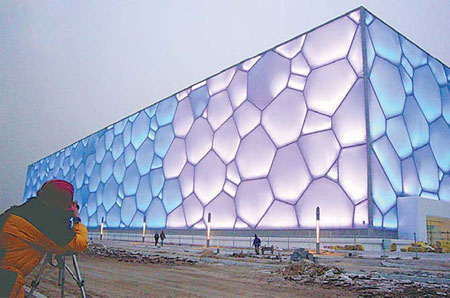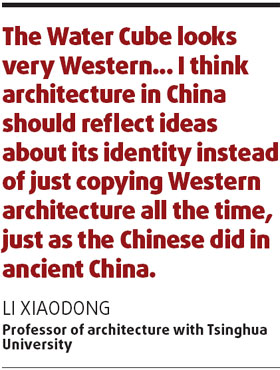 With the lights on, the Water Cube acquires a dreamlike character. [China Daily]
With the lights on, the Water Cube acquires a dreamlike character. [China Daily] |
As a symbol of change in China, from socio-political transformation to increased East-West collaboration and a new energy-saving consciousness, the National Aquatics Center takes some beating.
It has touched off a debate on the influence of foreign architecture in Beijing, too, sparking something of a domestic backlash with experts questioning whether the "Water Cube" is an example of Chinese architecture with Western characteristics, or a Western-style building with a Chinese flavor.
"The Water Cube looks very Western," says Tsinghua University's professor of architecture Li Xiaodong. "I think architecture in China should reflect ideas about its identity instead of just copying Western architecture all the time, just as the Chinese did in ancient China."
Australian firm PTW Architects' regional director John Pauline disagrees. "When you drive around Beijing, buildings aren't necessarily or obviously Chinese. In fact, it's (becoming) incredibly difficult to define 'Chineseness' in architecture," says Pauline, whose company is part of a consortium that designed the Olympic swimming center.

The Water Cube, famous for its bubble-like outer cladding made of ethylene-tetrafluoroethylene (ETFE), will stage a pre-Olympic test event at the end of this month, about 50 months after construction work began.
During the August 8-24 Olympics Games, it will host swimming, diving and synchronized swimming events, with a total of 42 gold medals up for grabs.
The building not only has quintessential Chinese elements, but also serves as a visual metaphor for how China is opening up to the world, Pauline says. "The square shape represents a contained series of spaces, but the aesthetics of the structure, being so transparent, is the very opposite of a caged-in building. It's definitely projecting its interiors outside, and allowing the outside to come inside."
The rectilinear shape and moat harks back to the blueprint of the Forbidden City, or the city wall that rings the former capital of Xi'an, home of the Terracotta Warriors. Another layer of meaning is added if we compare it to the oval-shaped Bird's Nest next door - because they have been shaped and positioned to conform to the classical Chinese concept of yin and yang, with each straddling a key North-South axis of the city.
"This is a perfect hybrid of Chinese and Australian sensibilities and styles," says Pauline. Like many of Beijing's new signature buildings, such as the under-construction China Central Television (CCTV) headquarters, or the egg-shaped National Center for Performing Arts, the Water Cube exhibits increased foreign influence on and internationalization of the city's architectural design.
This growing foreign influence can also be felt at Wukesong Indoor Stadium, venue for the Olympic basketball competition. The NBA, of the United States, is expected to announce at the end of this month that, along with its marketing partner, it will assume full charge of the stadium after the Games.
While many find the globalization of the city's skyline a welcome change, others beg to differ. "This debate on the positive and negative impact of Western architecture on China has been raging for more than 50 years," says Huang Jieran, a designer with a real estate company in Beijing.
China relies on the West to compensate for the slower pace of its own development, he says. "Traditional Chinese architecture has some limitations because of the material and the technology used. To keep pace with the times, we cannot say 'no' to every Western element. At the same time, we can add traditional elements to the design, such as applying Chinese colors and paying attention to little details."